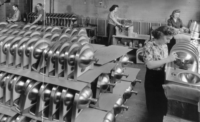NP Media Plumbing Group Multimedia Editor Nadia Askar recently sat down with Michael Whiteside, president and owner of Chicago-based MIFAB. The manufacturer has been family owned since 1982, and in early August celebrated the groundbreaking on its 68,000-sqaure-foot expansion of its Chicago facility.
pme: What are some of the trends MIFAB has seen over the years?
MW: We see a real trend in the plastic interceptor category where more and more restaurant owners and specifying engineers and contractors are considering plastic or HDPE high-density polyethylene grease and oil interceptors instead of the traditional steel interceptors. We still make steel and stainless steel interceptors here, but we’re seeing those sales decline, and we’re seeing the sales of the plastic interceptors increase because we offer a lifetime warranty with the plastic interceptors.
The other trend we’re seeing is in drainage. We’re seeing a lot more interest in our Hydromax siphonic roof drains. Siphonic roof drains result in smaller-diameter pipe, less pipe. The reason is, if a project is using siphonic roof drains, then we’ll have, say, 10,000 feet of pipe instead of 20,000 feet of pipe, if it’s gravity. And the diameter of that pipe would be 4 inches instead of 8 inches. So there’s significant material cost savings in pipe, in couplings, as well as significantly less labor to install the siphonic system, and, of course, significantly less impact on the environment because we’re using fewer materials to make that project.
So more and more engineers, more owners with the difficulty of getting good, qualified labor are realizing the time advantages of siphonic, along with the cost savings in a competitive bid market.
pme: How is MIFAB’s relationship with specifying engineers?
MW: We go out of our way to have as good a relationship as we possibly can. We visit the engineers and ask them to consider specifying our products for their new construction buildings because of the quality of our stainless steel drains. Also, there is the cost savings and other labor advantages that we have in our other products. We try to spend most of our time at the contractor and the engineer level to create demand for our product, but we’re always there for our wholesale customers to give them the support that they need.
pme: Where do you see the company in five years? 10 years?
MW: Hopefully filling up our new expansion. We’re going from 60,000 square feet to 128,000, it’s really more than what we need right now, but all the onetime costs of doing the design and organizing it and the permit fees, we might as well build out as much as we can.
There are three categories that I see really growing our company. One is plastic interceptors. I see a lot more growth in that space. Two is the BEECO backflow preventers and related products. We’re just getting into that with our University of Southern California approval, which is the main approval in the United States. We just received that a few months ago. So we’re just getting into that market, as a big market.
The third category is our patented no-hub coupling that really speaks to the labor issue that contractors are facing. A contractor can install a no-hub coupling on the pipe in 40% less time than the traditional coupling. So we see those three products, in particular, leading our growth and filling up that new expansion.





